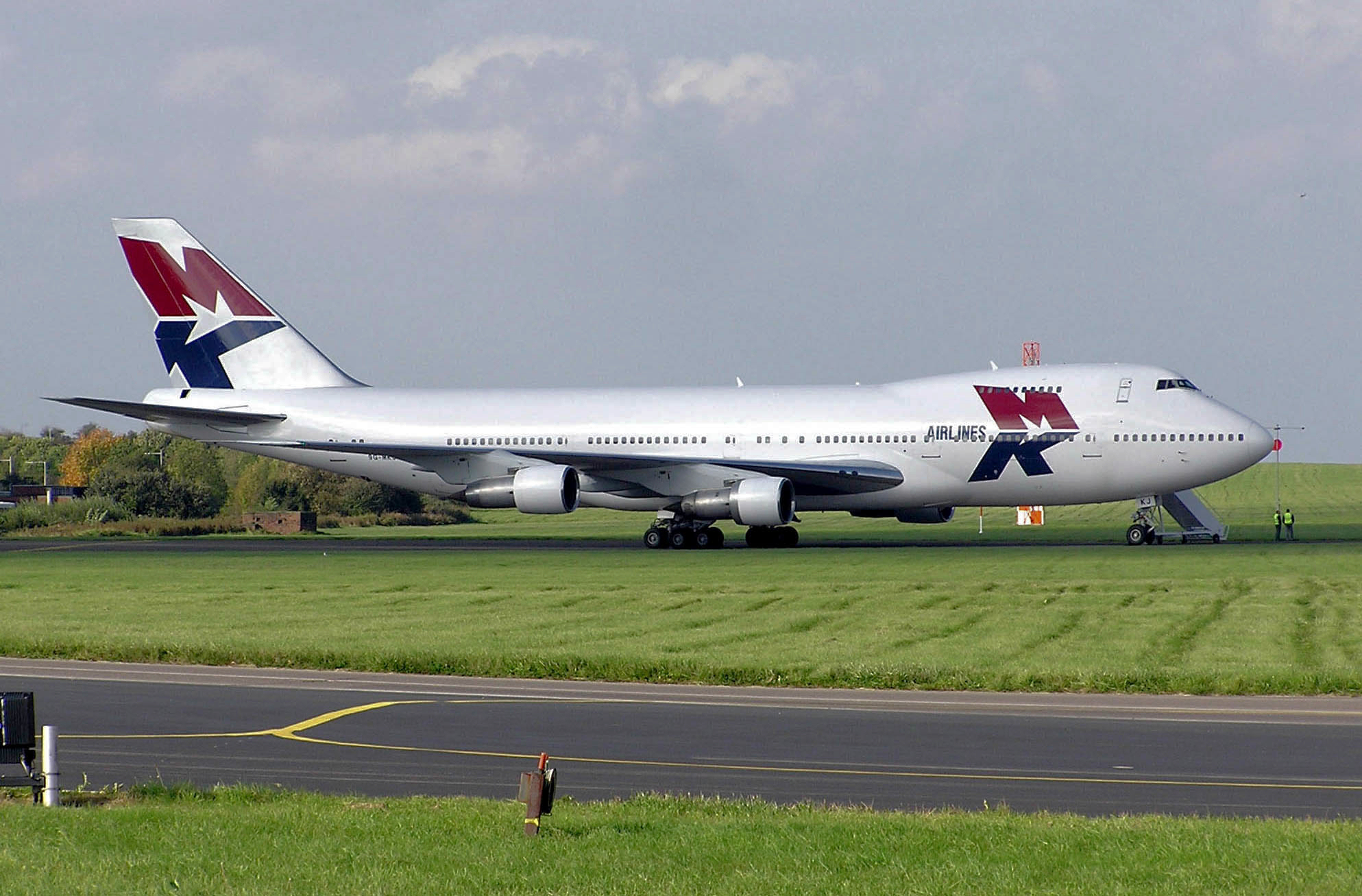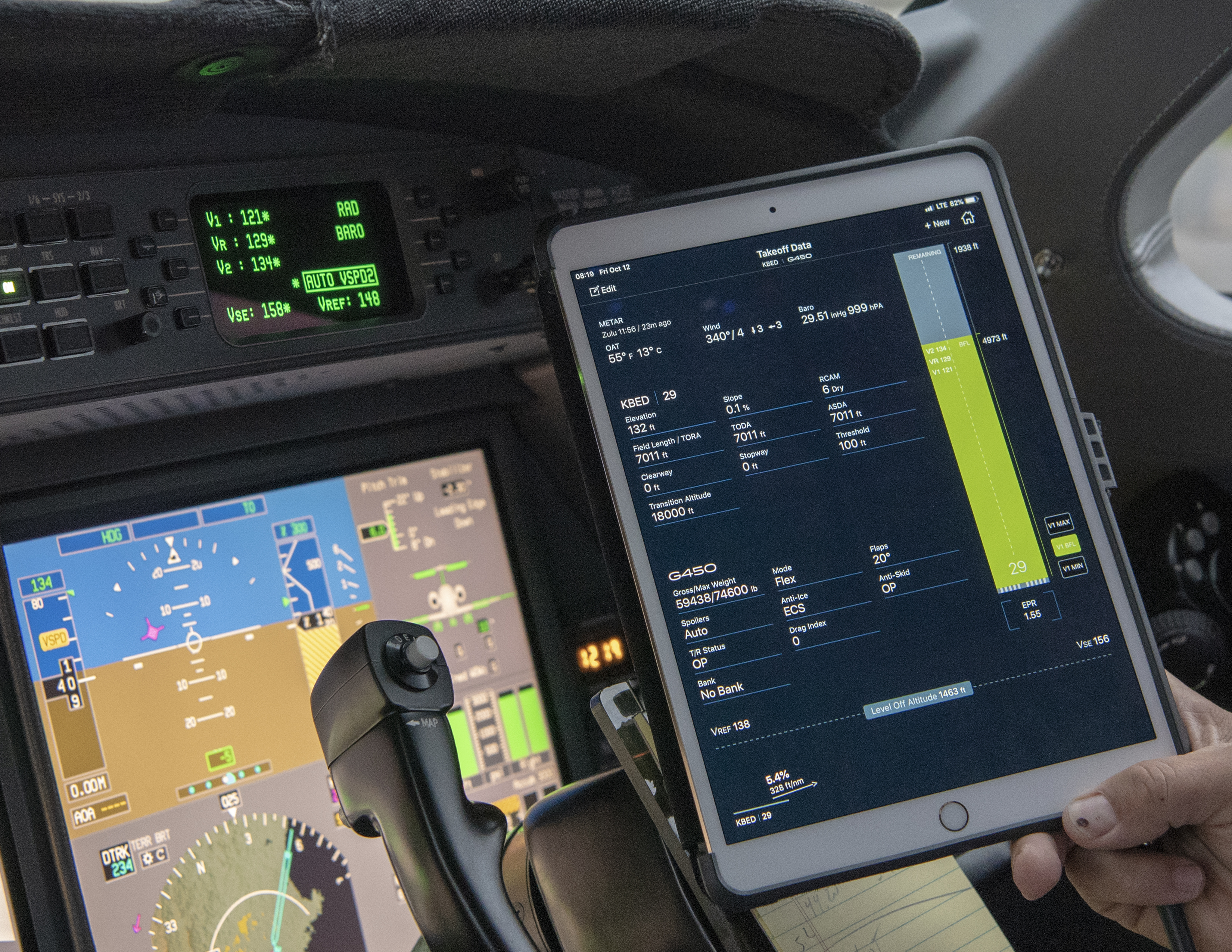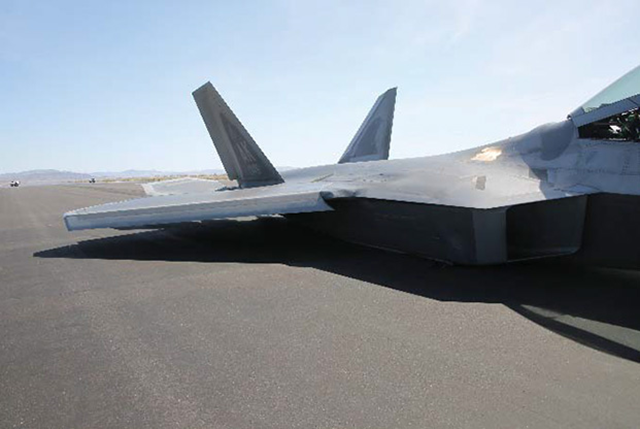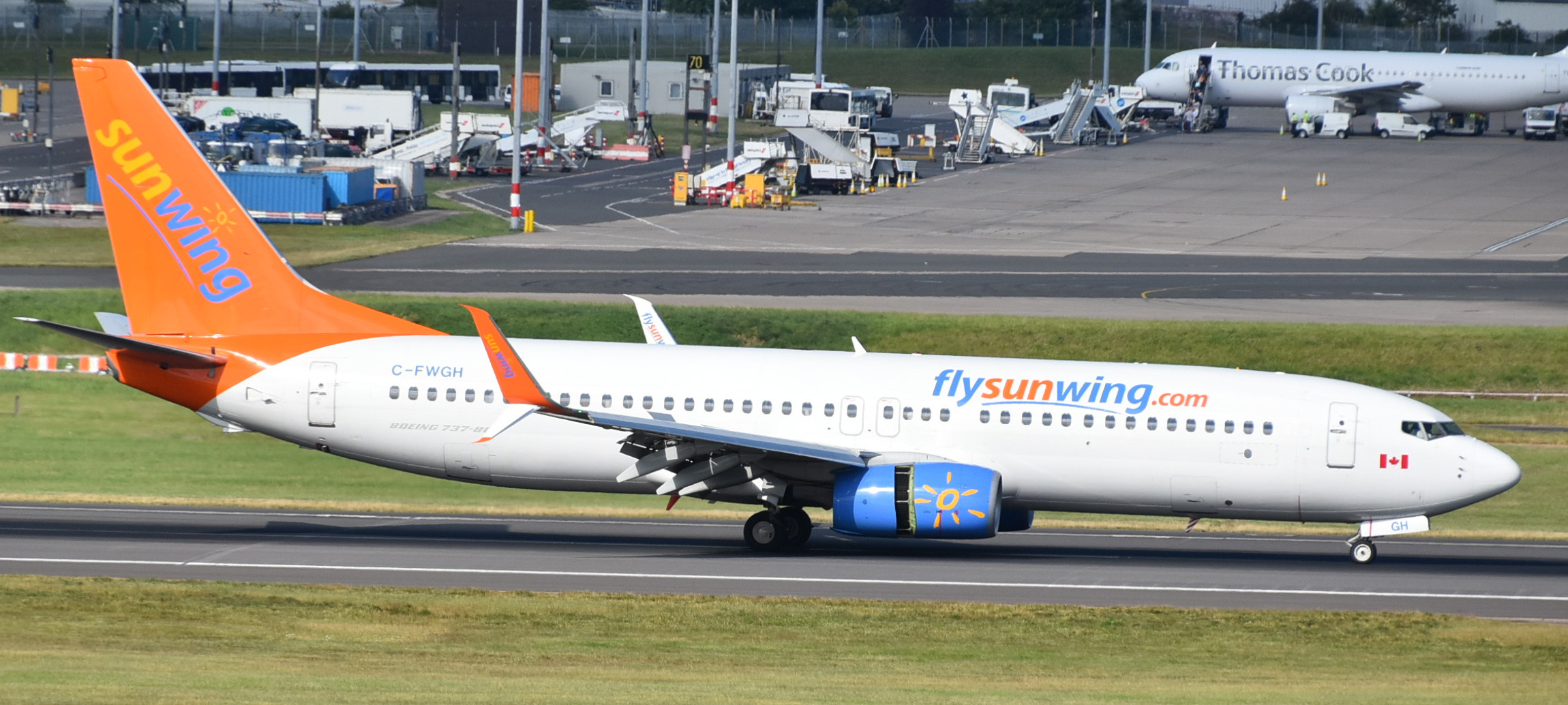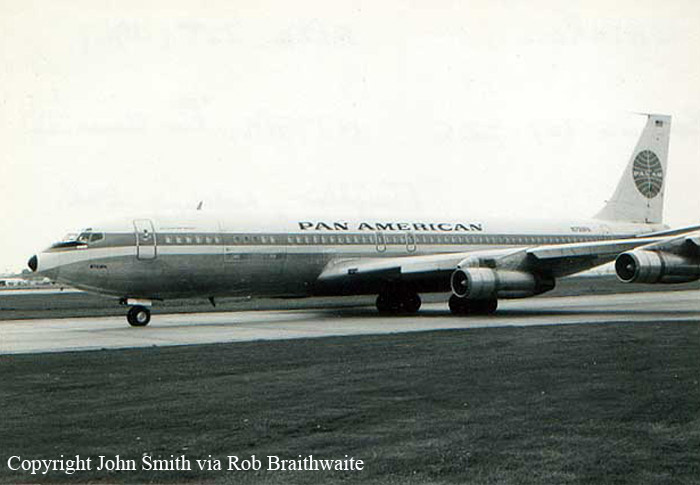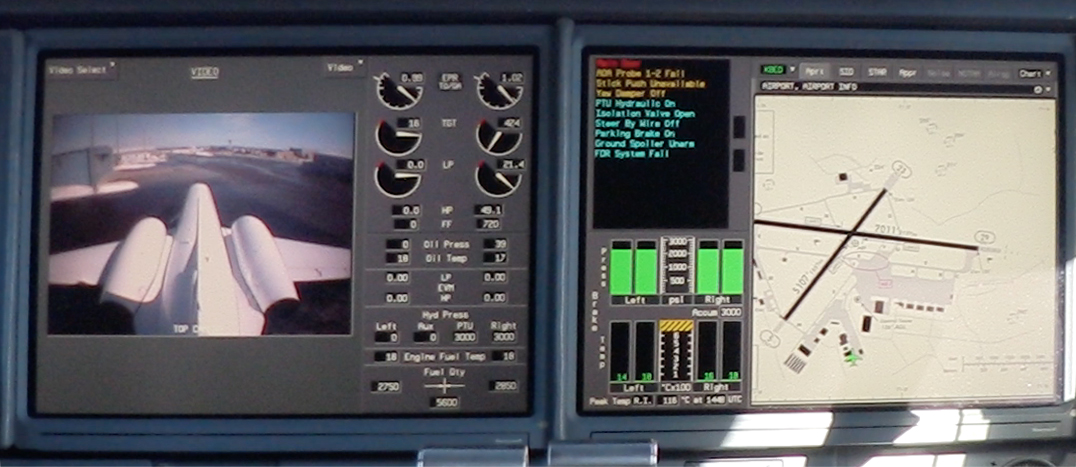There is a theory in military aviation that enemy flak, anti-aircraft rounds, or even missiles don't matter because only the one that has your name on it is meant for you. If it was your time to go, the "Golden BB" with your name was going to get you no matter what you did. (A "BB" is the pellet fired by a pellet gun.)
— James Albright

Updated:
2018-11-22
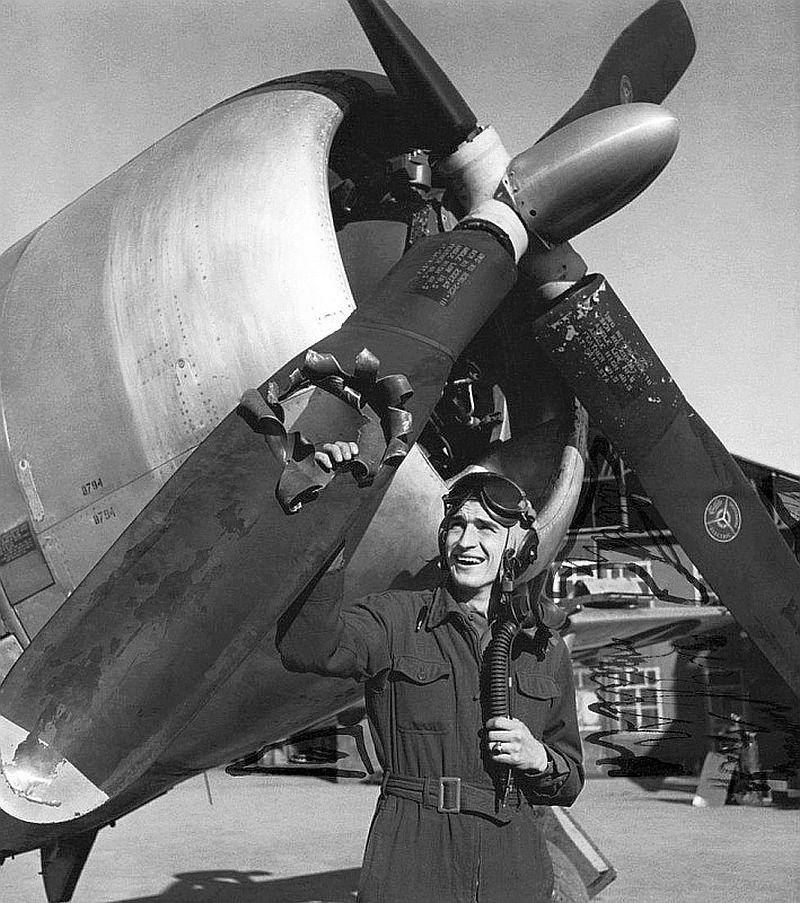
Lt Edwin Wright
looking over flak damage
following a mission over Münster, Austria,
Oct 1944 (Public Domain photo)
My theory is a little different. I do believe there are Golden BBs out there, but they don't have your name on them. They are first come, first serve. Your job as a professional pilot is to learn how to dodge them. And after you've done that, it is your duty to teach others the lessons you have learned.
So all this begs the question, how do you dodge that Golden BB if you can't see it coming for you? Well, you have to be observant. And then you can study cases where the Golden BB found its mark. Remember, these Golden BBs never travel alone. Just because someone else got hit, doesn't mean there isn't another identical round looking for another victim.
1 — The takeoff data Golden BB
2 — The takeoff configuration Golden BB
3 — The single-engine taxi Golden BB

1
The takeoff data Golden BB
Many years ago every takeoff in a large transport category aircraft involved chasing through performance charts to determine how much weight could be carried (fuel and cargo) and then to compute the necessary takeoff data performance speeds to allow a safe takeoff, even with an engine failure. We then started using those charts to see how little thrust we could use for given conditions, in an effort to save fuel, reduce engine wear, and sometimes reduce noise. The advantage of this "spaghetti chart" method is the pilot became very aware of what numbers looked right and what didn't. The disadvantages were that it took time and pilots tend to make errors when chasing lines through multiple pages of charts. Enter the computer.
The Golden BB
The "computer" can be a laptop, an iPad, or even the performance function of your FMS. But the FAA's view of this computer is that it puts out numbers and it is up to you to say the numbers are okay. Even if you punch in the right inputs, there is a chance the computer will punch out the wrong outputs. Or it may be a case of "garbage in, garbage out." In either case, it is you, the pilot, who is ultimately responsible for having good takeoff and landing data. Mistakes, no matter the source, can be deadly.
Case Study: MK Airlines 1602
There have been a few transport category aircraft lost over the years because of improperly computed takeoff data, perhaps the worst was that of MK Airlines Flight 1602.
On October 14, 2004, this Boeing 747 took off from Windsor Locks-Bradley International Airport (KBDL) with a load of lawn tractors. The total gross weight was 240,000 kg. The aircraft landed, refueled, and took on more cargo (lobsters) at Halifax International Airport, Nova Scotia, Canada (CYHZ). The total gross weight was 353,000 kg but the pilots failed to enter the new weight into their laptop computer, only updating the weather and airport. They ended up using a reduced thrust setting. When the aircraft failed to lift off at the computed rotation speed, the pilot pulled back further, resulting in aft fuselage contact with the runway. The aircraft finally became airborne 670 feet beyond the paved surface, but the aft fuselage struck an earthen berm and separated on impact. The rest of the aircraft continued in the air for another 1200 feet before striking the terrain and bursting into flames. All seven on board were killed.
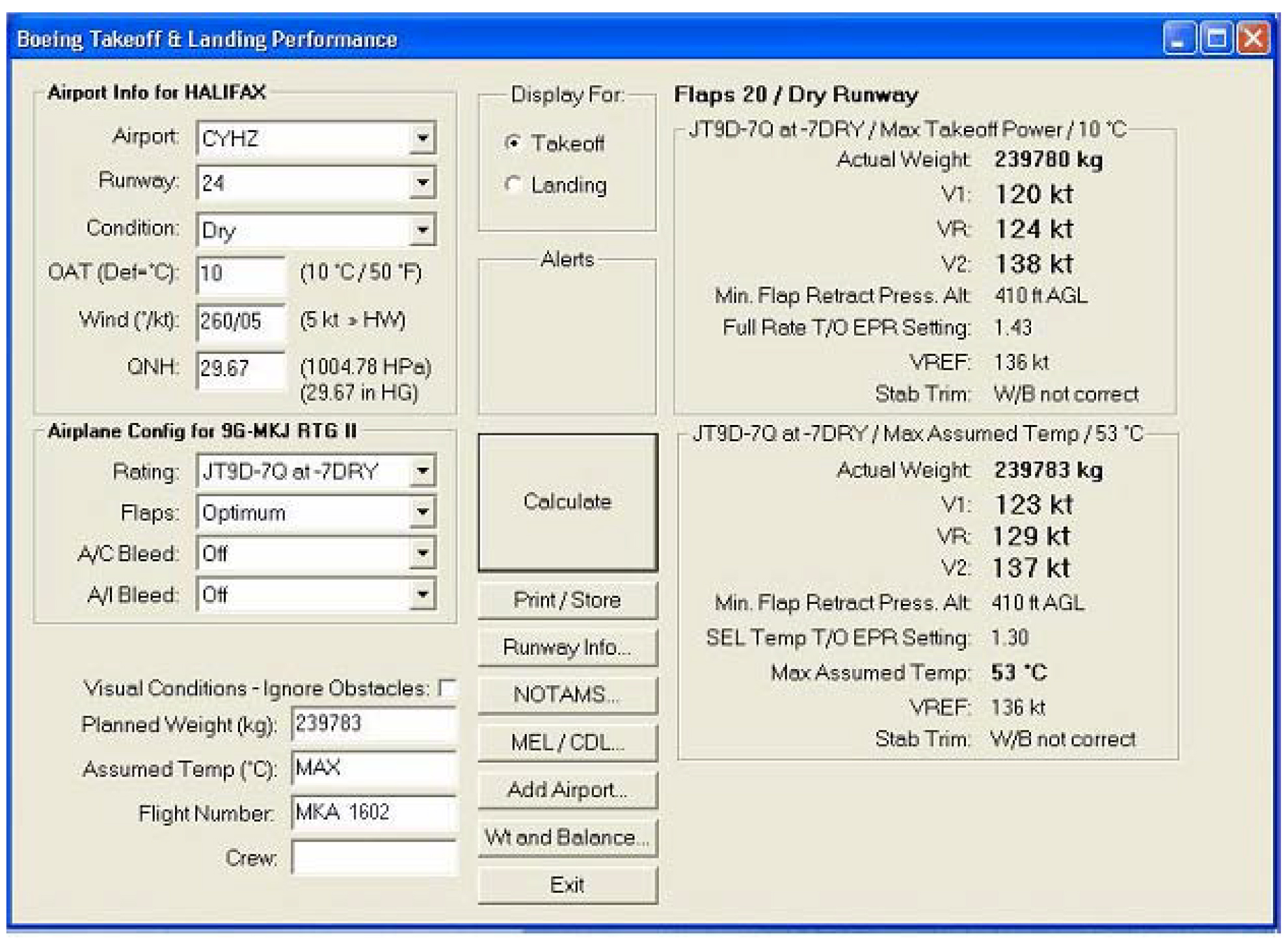
MK Flight 1602 Takeoff and Landing Performance, AIR A04H0004, figure 6.
MK Airlines required its crews to verify the computer generated numbers. One method would be to verify the numbers using Volume 2 of the Boeing 747 AFM, which would have been time consuming. Another method, which the accident report seems to indicate was an acceptable means of compliance, was to have a second crewmember use the laptop to verify the first crewmember's work. A more likely method would be for the pilots to simply look at the numbers and agree that they were, "about right."
In the case of the accident airplane, the differences in the numbers should have been apparent. Between 240,000 kg and 353,000 kg the target thrust setting was very close: 1.33 versus 1.30. But the correct V1, Vr, and V2 values were substantially higher: 150 not 123, 161 not 129, and 172 not 137. Fatigue, of course, may have affected each pilot's judgment.
Learning from the Golden BB
You may argue that the range in speeds for a cargo Boeing 747 are much greater than for a business jet where the largest factor is fuel and is unlikely to render a V-speed off by 30 knots. But if you examine your performance manual, you should find that you too can be placed in an unflyable situation because of improperly computed takeoff data.
For aircraft where the variability in speeds and thrust settings are small, "that looks about right" may be a valid verification method. But a better method would be to have an independent source of takeoff data. If you are using computer software developed by the manufacturer, it may be prudent to run data from another source, such as the aircraft's quick reference handbook or performance manual. Even the iPad application method is better than just looking at the numbers and saying, "that looks about right." You might argue that both sources are derived from the AFM, but this gives you a second chance at data entry and recording and doubles your chances of detecting an error.
Postscript 1
Bad takeoff data can burn you even with afterburners. This from Air Force Magazine, 11/16/18:
- An F-22 pilot took off with incorrect data and prematurely retracted the aircraft’s landing gear during a training flight in April at NAS Fallon, Nev., causing the aircraft to land on its belly and skid to a stop, the Air Force announced.
- On April 13, an F-22 pilot from the 90th Fighter Squadron at JB Elmendorf-Richardson, Alaska, took off from Fallon for a TOPGUN graduation exercise. The pilot rotated the aircraft — bringing the nose up — at 120 knots and as the aircraft indicated its wheels were leaving the ground, the pilot retracted the landing gear. Immediately after landing gear retracted, the aircraft “settled” back on the runway with the doors fully closed.
- The F-22 slid about 6,514 feet until coming to a rest, with its tailhook bouncing off the ground. Once the F-22 came to a stop, the pilot egressed the cockpit and there was no damage to other property. The Air Force did not disclose a cost estimate to the damage.
- The Accident Investigation Board found that the pilot had incorrect Takeoff and Landing Data for the conditions at Fallon — the pilot’s lineup card stated 136 knots indicated airspeed knots for rotation and 163 knots for full takeoff while that day’s conditions called for 143 knots for rotation and 164 knots for takeoff.
- The investigation also found that the pilot prematurely retracted the landing gear and that day’s flight brief was inadequate.
- Additionally, the F-22 community has “organizational overconfidence” in the equipment, formal training is not adequate, and there is an organizational acceptance of an incorrect technique of taking off in the F-22, the board found.
Postscript 2
How much time and effort do you devote to entering the environmental conditions into your FMS? And once that is done, do you review the resulting takeoff data? The following from Aircraft Accident Report 2/2018 regarding a Sunwings Airlines B-737:
- At 1539 hrs on 21 July 2017, a Boeing 737-800 took off from Belfast International Airport (BFS) with insufficient power to meet regulated performance requirements. The aircraft struck a supplementary runway approach light, which was 36 cm tall and 29 m beyond the end of the takeoff runway.
- An outside air temperature (OAT) of -52°C had been entered into the Flight Management Computer (FMC) instead of the actual OAT of 16°C. This, together with the correctly calculated assumed temperature thrust reduction of 48°C, meant the aircraft engines were delivering only 60% of their maximum rated thrust. The low acceleration of the aircraft was not recognised by the crew until the aircraft was rapidly approaching the end of the runway. The aircraft rotated at the extreme end of the runway and climbed away at a very low rate. The crew did not apply full thrust until the aircraft was approximately 4 km from the end of the runway, at around 800 ft aal.
2
The takeoff configuration Golden BB
There are all sorts of checklist items that, if missed, can kill. You might argue that flight is a dynamic environment and we can be excused for missing a step here and there while flying airplanes. But what about those items you miss while still a ground vehicle, before takeoff? There have been several transport category aircraft lost because the pilots forgot to set their flaps, or mis-set their stabilizer or rudder trim prior to takeoff. It may be necessary to go beyond the checklist to dodge these Golden BBs.
The Golden BB
The time between engine start and takeoff can be very busy and filled with distractions. A successful takeoff nearly always depends on having the aircraft's flaps and trim properly set. That's why those items appear on the checklist and why many aircraft have mechanical and computerized safeguards to ensure they are indeed set for takeoff. But we still have example after example where checklists and all those safeguards have failed us.
Case Study: Pan American Airlines 799
The three-pilot crew of this cargo Boeing 707 was distracted by having to manage a controlled departure time and had poor checklist discipline leading to the flaps being set, then retracted, and then forgotten prior to takeoff. The aircraft's takeoff configuration warning wasn't triggered because the cold temperature allowed takeoff thrust without reaching the minimum throttle angle to reach the warning microswitch. The aircraft stalled after takeoff and crashed, killing all three on board. More about this: Pan American Airlines Flight 799.
Since this crash there have been at least 22 more crashes of transport category aircraft due to pilots forgetting to set their flaps prior to takeoff. But modern checklists and warning computers have made this a problem of the past, right? The NASA Aviation Safety Reporting System (ASRS) begs to differ.
Case Study: Part 121 Air Carrier CRJ200 (ASRS)
In 2016 an airline captain opted to taxi single-engine because of the substantial taxi distance to their planned runway. When they were offered a closer runway during the taxi, the first officer was faced with starting the second engine, making an announcement to the cabin, and completing the checklist. The captain entered the new performance data into the FMS and accepted takeoff clearance with tower. The first officer asked the Captain, "do you want me to tell him (Tower) we need a little more time?" The Captain said "no, everything's set, just finish up the taxi and before takeoff checklists". In the words of the first officer: "The takeoff appeared to be progressing normally through 80 knots. It was some time after that when I saw the Captain move his right hand off the thrust levers and to the flaps selector, changing it from 8 to 20. It took me a moment to process what I was seeing and then I concluded that he must have realized that, perhaps, the FMS actually did indicate that 20 was required even though he had told me to leave them set at 8. By this time, I believe that we may have been at a very high speed and possibly nearing V1."
As reported by the first officer, "I had no idea what to say in this case other than 'shouldn't we abort?' But, before I could say anything, the Captain quickly went to idle thrust and applied hard braking."
Case Study: USAir 5050
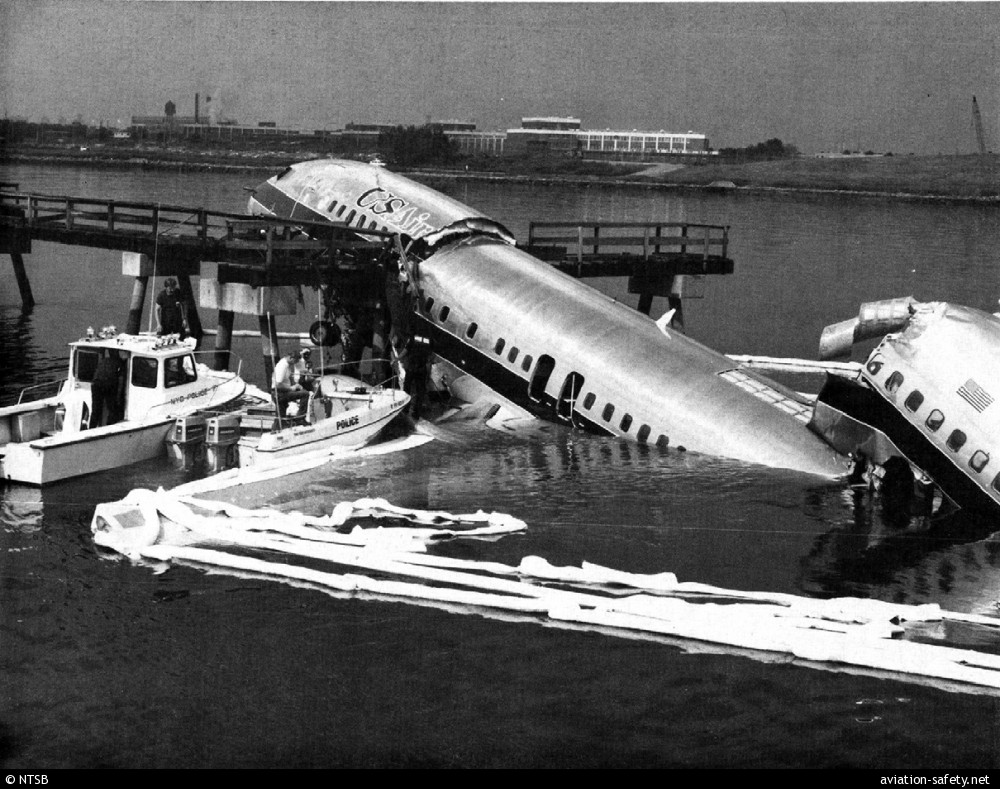
USAir 5050 N416US, from NTSB/AAR-90/03
A USAir Boeing 737 ended up in Flushing Bay while trying to takeoff from La Guardia Airport on September 20, 1989. There is circumstantial evidence that a cockpit visitor could have rested his foot on the cockpit center console and pushed the rudder trim knob. The pilots failed to check the trim when they accomplished the checklist item, "stabilizer and trim." The captain and first officer made other mistakes during the takeoff roll and subsequent abort. No matter the causes, the pilots didn't pay enough attention to the rudder trim prior to takeoff. Two of 57 passengers were killed. More about this: US Air Flight 5050.
Since the 1989 US Air incident, there have been several cases of transport category aircraft failing to rotate when the pitch trim was not correctly set for takeoff. There has been at least one case of another transport category aircraft unable to maintain directional control because the rudder trim wasn't correctly set.
Learning from the Golden BB
A common theme in many of these incidents where the flaps or trim were not set is that pilots either skipped the checklist item, or saw what they wanted to see (that the flaps or trim were set when they were not). In the first case, the answer is greater cockpit discipline when it comes to accomplishing checklists. In the case of seeing what you want to see, the so-called "expectation bias," I recommend adding tactile and aural senses when it comes to all aircraft configuration changes. More about this: Pointing and Calling (Shisa Kanko).
3
The single-engine taxi Golden BB
We routinely shut down our inboard engines in the Boeing 707 after landing to cut down on the noise. We sometimes taxied on only the outboards before takeoff in the Boeing 747 to lessen the possibility of ingesting FOD from the lower hanging inboards. But we had a flight engineer who could devote 100% of his attention to the task. But I've never delayed engine start prior to takeoff to have it started during taxi in a cockpit with only two pilots. My rationale is to have both pilots maximize their attention span outside the airplane while it is moving on the ground. The thought that we would actually forget to start the engine before takeoff never entered my mind. But, incredibly, that does happen.
The Golden BB
Single Engine Taxi (SET) is standard operations for some airlines operating two-engine aircraft. If you multiply the delay times at some airports by the sheer number of daily operations you end up with significant fuel savings. But the Golden BB waiting these airlines will pale by comparison to the losses sure to come after a single airplane and its passengers are ever lost.
I've heard of a couple of airlines where the crews made it to the runway and were cleared for takeoff without an engine running. In most cases, the crew figured it out. Here is a 2015 example reported through the NASA Aviation Safety Reporting System (ASRS):
Case Study: Part 121 Air Carrier CRJ200 (ASRS)
"On taxi out from the air carrier ramp, the captain elected to single-engine taxi for fuel conservation. The primary runway was closed and we needed to use runway 31 for departure. This entailed crossing 2 runways; one of which had a light aircraft on it that we were to pass behind. It was a short taxi from the gate to the runway and I was inundated with checklists, briefings and the multiple runway crossings. I called the tower and advised we were ready for takeoff. We were cleared for takeoff and the captain ordered me to perform the takeoff checklist."
"When I looked at the overhead panel, I realized the fuel pumps were off indicating the second engine had not been started. I advised the captain that the engine was not started. We had already taxied over the hold short line, so I advised the tower we needed to clear the runway and taxi back to the approach end. After engine start, we reran all the appropriate checklists and departed without incident. It is worth noting that the aircraft could not have taken off with one engine shut down since the thrust lever was in the shutoff/locked position. A FADEC controlled engine like those installed on Embraer aircraft would not have such a safeguard. We were not more than a few feet over the hold short line when I made the captain aware of the situation and we never initiated the takeoff sequence."
"My airline is rolling out updated checklists and procedures next month to relieve the crew of so many checks and duties while on the taxi out. I knew this might happen at some point in my career because there is no checklist item that confirms that all engines are started prior to takeoff."
Case Study: Part 121 Air Carrier EMB-145LR (ASRS)
"We pushed off the gate starting engine #2. We taxied out with the plan to start the #1 engine [later in the taxi] after we saw the lineup. We then switched over to Tower. Just as we were pulling up to stop they cleared us on to the runway, so I ran the before takeoff checklist just reading through it and the Captain answering. I was the flying pilot so I said set thrust and he said thrust set."
"I stated twice that I was using a ton of rudder when he said that we do not have engine #1, abort takeoff. We did not travel far, took a breath and did checklist. We then started engine #1, went through all the checklist from delayed engine start and on, very diligently. We then called Tower and proceed to taxi back to the runway and took off.""
"I did ask the Captain if we needed to fill out an ASAP. He said let me think about it and later said he thought we would be fine."
"The event has not set well with me so I reached out to talk to someone about it and feel like I need to submit it even though it's past the 24 hour mark.""
Learning from the Golden BB
In the first case, it looks like the airline is taking steps to capitalize on a dodged Golden BB with checklist changes. In the second case, we have one pilot who seems to have learned a valuable lesson and another willing to ignore the lesson. Because they didn't file an Aviation Safety Action Program (ASAP) report, the airline misses an opportunity to learn from the dodged Golden BB.
But it gets worse. I’ve heard from pilots at a major US airline operating MD-80 series aircraft that they have had 8 incidents in the last few years of pilots forgetting to start the second engine during single engine taxi and making it to the runway with takeoff clearance. In one case, the crew ended up aborting doing about 90 knots. And yet this airline continues the practice of single engine taxi before takeoff. I asked a pilot at another major airline operating the same kind of equipment about this. He said they do not allow single engine taxi because of the distraction during high workload periods and the chance of forgetting to start the second engine.
In these examples the aircraft did have some kind of warning system and the crews were provided with electronic messages that something wasn't right. I've read about twenty of these reports where something distracted the crew before they got to the runway and they accepted their takeoff clearances with something left undone or unstarted. Most of those who were using SET procedures had the option to taxi on two engines, but believed they had enough time and a margin of safety to taxi single engine. What to do about this? See A Game Plan for Dodging Golden BBs, below.
4
The NOTAMs Golden BB
Think back to the last time you flew into Los Angeles, San Francisco, Chicago, Atlanta, or New York Kennedy airports. Did you carefully read every NOTAM? Let me show you two airport examples and the Golden BBs with each; one of which hit its mark and the other came within 14 feet of creating the single largest civil airplane disaster in history.
Case Study: Malaysia MH17
Let's say you were flying across Europe following a line of other airliners and noticed in the stack of eight NOTAMs for a country in the middle of your flight that said this:
A1493/14 NOTAM
Q) UKDV/QARLC/IV/NBO/E /260/320/4820N03716E119
A) UKDV
B) 1407141800 C) 1408142359EST
E) SEGMENTS OF ATS ROUTES CLOSED:
T242 NALEM MASOL M996 ABUGA GUKOL
G476 MASOL OLGIN W533 TOROS KUBIR
L32 NALEM KW P851 LS NESLO
A83 LS DIMAB L980 GANRA TAMAK
W538 GANRA FASAD W633 LUGAT MAKAK
L69 LAMIV GONED W644 DON GETBO
M70 BULIG TAMAK B493 PODOL FASAD
L984 BULIG FASAD W531 KOVIL PW
M136 MEBAM DON M995 OLGIN PENAK
L140 KOVIL FASAD.
FM FL 260 UP TO FL 320
First question: Do you understand what it is telling you? It is basically saying the airspace bounded by those coordinates is closed between FL 260 and FL 320.
Second question: If you are flight planned to fly over this airspace at FL 330 (above the NOTAM'd airspace), would you consider flying around it regardless, even if it meant adding thirty minutes or so to your flight? Thirty one operators (including Emirates, KLM, Lufthansa, Malaysian, and Singapore Airlines) overflew the airspace. Eight operators (including British Airways, Air France, and Qantas) flew around it.
Third question: If I told you that three days prior to your flight a large aircraft was shot at high altitude and the day prior a second one was downed, would that change your answer to question two?
Case Study: Air Canada
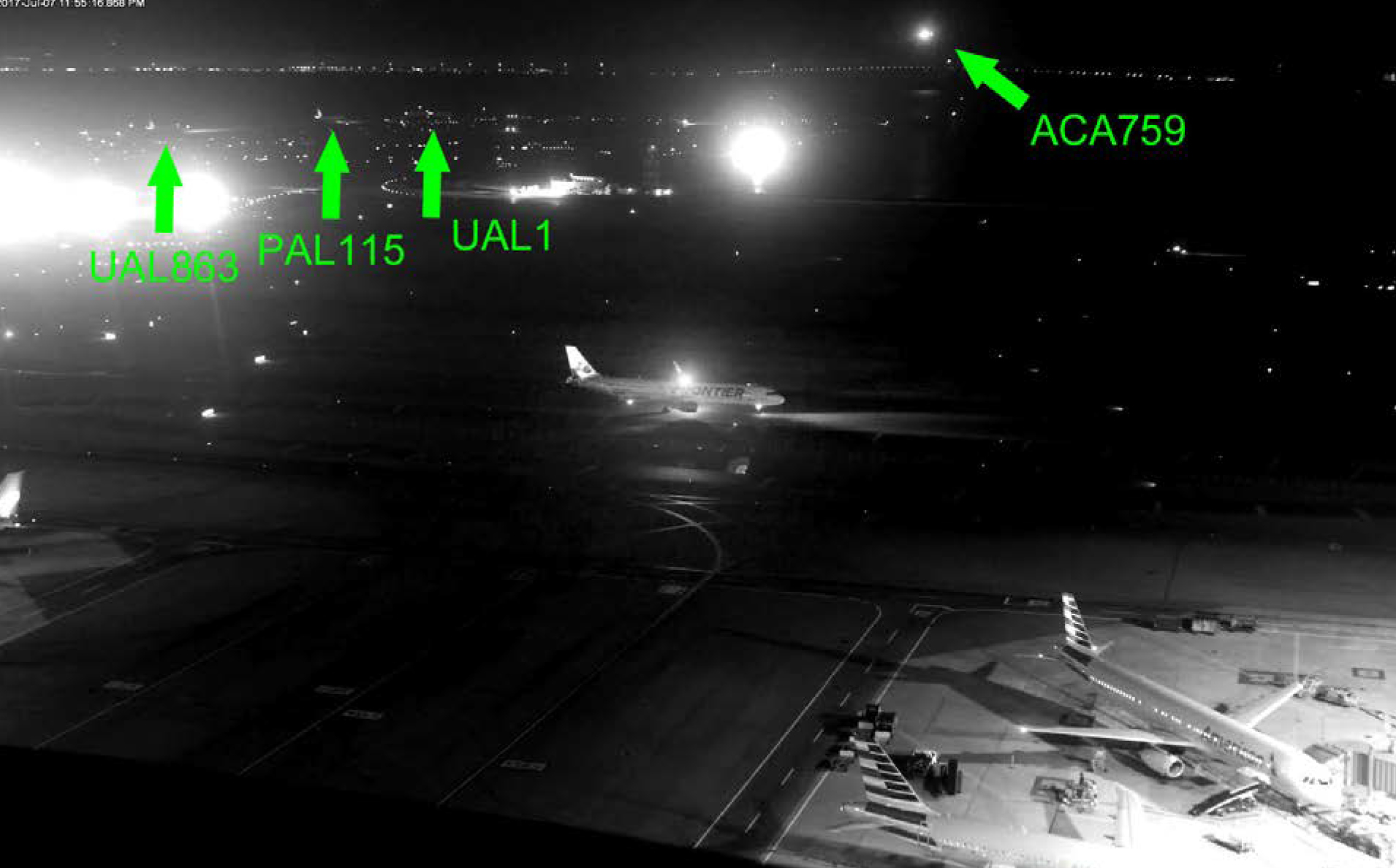
Air Canada 759 about to overfly three airliners on a taxiway, NTSB Accident Docket.
On July 7, 2017, about 2356 Pacific daylight time, Air Canada flight 759 (ACA759), an Airbus A320, Canadian registration C-FKCK, was cleared to land on runway 28R at San Francisco International Airport, San Francisco, California, but instead lined up on parallel taxiway C, where four air carrier airplanes (a Boeing 787 followed by an Airbus A340, another Boeing 787, and a Boeing 737) were awaiting takeoff clearance. ACA759 overflew the first airplane on the taxiway and descended below 100 ft above the ground, and the ACA759 flight crew initiated a go around. The flight was operated under the provisions of 14 Code of Federal Regulations Part 129 as an international scheduled passenger flight from Toronto/Lester B. Pearson International Airport, Toronto, Canada, with 135 passengers and 5 crewmembers on board. Night visual meteorological conditions prevailed at the time of the incident. The airplane was not damaged, and no injuries were reported.
These pilots screwed up, no doubt about it. They lined up on the taxiway thinking it was Runway 28R and that Runway 28R was actually Runway 28L. But why didn't they know Runway 28L was closed? It was right there in the NOTAMs:
!SFO 11/095 SFO RWY 28R DECLARED DIST: TORA 11870FT TODA 11870FT ASDA 11870FT LDA 11236FT. 1611220012-PERM
!SFO 11/094 SFO RWY 28L DECLARED DIST: TORA 11381FT TODA 11381FT ASDA 10981FT LDA10275FT. 1611220012-PERM
!SFO 04/189 SFO TWY S2 BTN TWY Z AND TWY S3 CLSD TO ACFT WINGSPAN MORE THAN 215FT1604291657-PERM
!SFO 05/248 SFO TWY N CL LGT BTN TWY F AND RWY 10L/28R OUT OF SERVICE 1705291227-PERM
!SFO 11/011 SFO APRON TAXILANE H1 CLSD 1611040934-PERM
!FDC 5/7988 SFO CANCELLED BY FDC 6/0989 ON 10/16/16 00:00
!FDC 7/6636 SFO IAP SAN FRANCISCO INTL, San Francisco, CA. RNAV (GPS) Z RWY 28R, AMDT 5A...LPV DA VISIBILITY RVR 1800 ALL CATS. THIS IS RNAV (GPS) Z RWY 28R, AMDT 5B. 1706212031-PERM
!FDC 7/6632 SFO IAP SAN FRANCISCO INTL, San Francisco, CA. RNAV (GPS) RWY 28L, AMDT 5A...CHART NOTE: ASTERISK, ASTERISK RVR 1800 AUTHORIZED WITH USE OF FD OR AP OR HUD TO DA. CHANGE LPV DA TO LPV DA ASTERISK, ASTERISK. THIS IS RNAV (GPS) RWY 28L, AMDT 5B. 1706212029-PERM
!SFO 02/024 SFO OBST CRANE 2016-AWP-3215-NRA 373656N1222304W (1500FT W APCH END RWY 01L) 133FT (125FT AGL) FLAGGED AND LGTD 1702031340-2208031340
!SFO 02/023 SFO OBST CRANE 2016-AWP-3080-NRA 373654N1222303W (1500FT W APCH END RWY 01L) 133FT (125FT AGL) FLAGGED AND LGTD 1702031340-2208031340
!SFO 02/025 SFO OBST CRANE 2016-AWP-3216-NRA 373650N1222318W (1500FT W APCH END RWY 01L) 133FT (125FT AGL) FLAGGED AND LGTD 1702031340-2208031340
!SFO 02/026 SFO OBST CRANE 2016-AWP-3217-NRA 373643N1222311W (1500FT W APCH END RWY 01L) 133FT (125FT AGL) FLAGGED AND LGTD 1702031340-2208031340
!SFO 02/027 SFO OBST CRANE 2016-AWP-3218-NRA 373648N1222258W (1500FT W APCH END RWY 01L) 133FT (125FT AGL) FLAGGED AND LGTD 1702031340-2208031340
!SFO 10/047 SFO OBST CRANE (ASN 2016-AWP-2427-OE) 373536N1222306W (1.6NM SSW SFO) 100FT (61FT AGL) LGTD 1610112035-1804112300
!SFO 03/212 SFO OBST CRANE (ASN 2016-AWP-2987-NRA) 373724N1222352W (1.1NM WNW SFO) 251FT (245FT AGL) FLAGGED AND LGTD 1703242254-1712161200
!SFO 03/213 SFO OBST CRANE (ASN 2016-AWP-2988-NRA) 373724N1222353W (1.1NM WNW SFO) 251FT (245FT AGL) FLAGGED AND LGTD 1703242255-1712161200
!SFO 03/214 SFO OBST CRANE (ASN 2016-AWP-2989-NRA) 373723N1222353W (1.1NM WNW SFO) 251FT (245FT AGL) FLAGGED AND LGTD 1703242300-1712161200
!SFO 03/215 SFO OBST CRANE (ASN 2016-AWP-2990-NRA) 373723N1222355W (1.1NM WNW SFO) 251FT (245FT AGL) FLAGGED AND LGTD 1703242308-1712161200
!SFO 03/216 SFO OBST CRANE (ASN 2016-AWP-2991-NRA) 373722N1222356W (1.1NM WNW SFO) 251FT (245FT AGL) FLAGGED AND LGTD 1703242308-1712161200
!FDC 6/7354 SFO STAR SAN FRANCISCO INTL., SAN FRANCISCO, CA. BIG SUR THREE ARRIVAL...FROM OVER ANJEE INT CHANGE MINIMUM HOLDINGALTITUDE TO READ: 11000FT. 1612061900-1712052359EST
!FDC 6/7361 SFO STAR SAN FRANCISCO INTL., SAN FRANCISCO, CA. BIG SUR THREE ARRIVAL...FROM OVER BSR VORTAC TO CARME, THENCE FROM OVER CARME TO ANJEE INT REVISE MINIMUM EN ROUTE ALTITUDE TO READ: 11000FT. 1612061900-1712052359EST
!SFO 04/069 SFO OBST CRANE (ASN 2016-AWP-2357-NRA) 373703N1222260W (0.4NM WSW SFO) 251FT (240FT AGL) FLAGGED AND LGTD 1704100700-1711301200
!FDC 6/9114 SFO STAR SAN FRANCISCO INTL, SAN FRANCISCO, RISTI FOUR ARRIVAL ADD NOTE TO READ: PROPS AND TURBO PROPS ONLY. 1611162030-1711152359
!FDC 6/9115 SFO STAR SAN FRANCISCO INTL., SAN FRANCISCO, CA. POINT REYES TWO ARRIVAL SAC VORTAC TO POPES INT, MEA 5100. 1611162030-1711152359EST
!FDC 7/5661 SFO SID SAN FRANCISCO INTL, San Francisco, CA. SSTIK THREE DEPARTURE (RNAV)... WESLA THREE DEPARTURE (RNAV)...YYUNG TRANSITION NA. ALL OTHER DATA REMAINS AS PUBLISHED. 1704051317-1711151317EST
!SFO 07/029 SFO OBST CRANE (ASN 2016-AWP-1309-OE) 373960N1222356W (3.1NM NNW SFO) 372FT (298FT AGL) FLAGGED AND LGTD 1607071857-1711100100
!FDC 7/2076 SFO ODP SAN FRANCISCO INTL, San Francisco, CA. TAKEOFF MINIMUMS AND (OBSTACLE) DEPARTURE PROCEDURES AMDT 9...TAKEOFF MINIMUMS: RWY 28L, 28R, STANDARD WITH A MINIMUM CLIMB OF 415FT PER NM TO 1300. ADD NOTE: RWY 19R, TEMPORARY CRANE 935FT FROM DER, 609FT RIGHT OF CENTERLINE, 125FT AGL/135FT MSL (2016-AWP-2003-NRA). RWY 28L, TEMPORARY CRANE 1.39 NM FROM DER, 2831FT LEFT OF CENTERLINE, 350FT AGL/ 448FT MSL (2016-AWP-10862-OE). RWY 28R, TEMPORARY CRANES BEGINNING 3043FT FROM DER, 762FT RIGHT OF CENTERLINE, UP TO 120FT AGL/ 131FT MSL (2015-AWP-1790-NRA, 2015-AWP-1839 THROUGH 1842-NRA). TEMPORARY CRANE 1.31 NM FROM DER, 3581FT LEFT OF CENTERLINE, 350FT AGL/ 448FT MSL (2016-AWP-10862-OE). ALL OTHER DATA REMAINS AS PUBLISHED. 1703291326-1711081326EST
!FDC 7/2077 SFO SID SAN FRANCISCO INTL, San Francisco, CA. GAP SEVEN DEPARTURE... MOLEN EIGHT DEPARTURE... OFFSHORE ONE DEPARTURE... SAN FRANCISCO FOUR DEPARTURE... TAKEOFF MINIMUMS: RWY 28L, 28R, STANDARD WITH A MINIMUM CLIMB OF 415FT PER NM TO 1300. ADD TAKEOFF OBSTACLE NOTE: RWY 19R, TEMPORARY CRANE 935FT FROM DER, 609FT RIGHT OF CENTERLINE, 125FT AGL/ 135FT MSL (2016-AWP-2003-NRA). RWY 28L, TEMPORARY CRANE 1.39 NM FROM DER, 2831FT LEFT OF CENTERLINE, 350FT AGL/ 448FT MSL (2016-AWP-10862-OE). RWY 28R, TEMPORARY CRANES BEGINNING 3043FT FROM DER, 762FT RIGHT OF CENTERLINE, UP TO 120FT AGL/ 131FT MSL (2015-AWP-1790-NRA, 2015-AWP-1839 THROUGH 1842-NRA). TEMPORARY CRANE 1.31 NM FROM DER, 3581FT LEFT OF CENTERLINE, 350FT AGL/ 448FT MSL (2016-AWP-10862-OE). ALL OTHER DATA REMAINS AS PUBLISHED. 1703291326-1711081326EST
!FDC 7/9012 SFO IAP SAN FRANCISCO INTL, SAN FRANCISCO, CA. ILS OR LOC RWY 28L, AMDT 25A ... ILS RWY 28L (SA CAT II), AMDT 25A ... TERMINAL ROUTE ARCHI (IAF) TO PONKE/I-SFO 21.6 DME MINIMUM ALTITUDE 6000 1702282122-1710102119EST
!SFO 03/277 SFO OBST RIG (ASN UNKNOWN) 373723N1222353W (1.16NM WNW SFO) 96FT (86FT AGL) FLAGGED 1703311400-1710020001
!SFO 06/142 SFO APRON TXL M1, M2 CLSD 1706261717-1709010700
!SFO 05/132 SFO RWY 10R/28L NOT GROOVED 1705172226-1709010500
!FDC 7/0273 SFO CA..SPECIAL NOTICE..SAN FRANCISCO INTERNATIONAL, CALIFORNIA, RWY STATUS LGTS ARE IN AN OPR TEST ON RWY 10L/28R, RWY 10R/28L, RWY 01L/19R, RWY 01R/19L AND MUST BE COMPLIED WITH. RWY STATUS LGT ARRAYS MAY BE OFFLINE INTERMITTENTLY THROUGHOUT THE TEST PHASE. RWY STATUS LGTS ARE RED IN-PAVEMENT LGTS THAT SERVE AS WARNING LGTS ON RWYS AND TWYS INDICATING THAT IT IS UNSAFE TO ENTER, CROSS, OR BEGIN TKOF ON A RWY. NOTE: RWY STATUS LGTS INDICATE RWY STATUS ONLY. THEY DO NOT INDICATE CLEARANCE. PILOTS AND VEHICLE OPRS MUST STILL RECEIVE A CLEARANCE FROM AIR TRAFFIC CONTROL BEFORE PROCEEDING. FOR ADDITIONAL INFORMATION VISIT: HTTP://WWW.FAA.GOV/AIR_TRAFFIC/TECHNOLOGY/RWSL 1705231700-1708302359
!SFO 04/166 SFO TWY J CLSD 1704140651-1708012359
!SFO 02/057 SFO OBST CRANE (ASN 2016-AWP-74-NRA) 373644N1222308W (0.6NM SW SFO) 158FT (150FT AGL) FLAGGED AND LGTD 1602111446-1708012300
!SFO 04/167 SFO TWY J CL LGT OUT OF SERVICE 1704140651-1708011200
!SFO 03/164 SFO APRON TAXILANE M CL LGT OUT OF SERVICE 1703211939-1707311300
!FDC 7/5705 SFO IAP SAN FRANCISCO INTL, San Francisco, CA. RNAV (RNP) Z RWY 10R, AMDT 2A... RNP 0.20 DA 409/ HAT 399 ALL CATS. TEMPORARY CRANES UP TO 131 MSL BEGINNING 3980FT NORTHWEST OF RWY 10R (2015-AWP-1790-NRA, 2015-AWP-1839 THROUGH 1842-NRA). 1704051332-1707301332EST
!FDC 7/5704 SFO SID SAN FRANCISCO INTL, SAN FRANCISCO, CA. AFIVA ONE DEPARTURE (RNAV)... GNNRR TWO DEPARTURE (RNAV)... NIITE THREE DEPARTURE (RNAV)... OFFSHORE ONE DEPARTURE... SAN FRANCISCO FOUR DEPARTURE... SNTNA TWO DEPARTURE (RNAV)... TRUKN TWO DEPARTURE (RNAV)... WESLA THREE DEPARTURE (RNAV)... ADD TAKEOFF OBSTACLE NOTE: RWY 28R, TEMPORARY CRANES BEGINNING 3043FT FROM DER, 762FT RIGHT OF CENTERLINE, UP TO 120FT AGL/ 131FT MSL (2015-AWP-1790-NRA, 2015-AWP-1839 THROUGH 1842-NRA). ALL OTHER DATA REMAINS AS PUBLISHED. 1704051331-1707301331EST
!SFO 06/018 SFO NAV ILS RWY 28L CAT II NA 1706021405-1707211500
!SFO 06/017 SFO RWY 28L ALS OUT OF SERVICE 1706021357-1707211500
!SFO 07/032 SFO OBST TOWER LGT (ASR 1205149) 374114.40N1222605.30W (5.1NM NW SFO) 1566.9FT (311.0FT AGL) OUT OF SERVICE 1707072337-1708072337
!SFO 07/031 SFO TWY D BTN RWY 10R/28L AND TWY B CLSD 1707101330-1707101800
!SFO 07/030 SFO RWY 10L/28R CLSD 1707100700-1707101430
!SFO 07/027 SFO RWY 10L/28R CLSD 1707090300-1707091500
!SFO 07/028 SFO RWY 01R/19L CLSD 1707090300-1707091500
!SFO 07/025 SFO RWY 01R/19L CLSD 1707080600-1707081500
!SFO 07/026 SFO RWY 10R/28L CLSD 1707080600-1707081500
!SFO 07/033 SFO NAV ILS RWY 28L OUT OF SERVICE 1707080600-1707081500
More about this: Case Study: Air Canada 759.
Learning from the Golden BB
I've been saying for a long time that the single purpose of NOTAMs is to protect everyone except the pilot. Contemplating the carnage that could have resulted in San Francisco, NTSB Chairman Robert Sumwalt said the NOTAMs were "Just a pile of garbage." A friend of mine, Mark Zee, is even less charitable. He runs OpsGroup. There you will find their most recent Overflight and Security Map. Here is a recent copy:
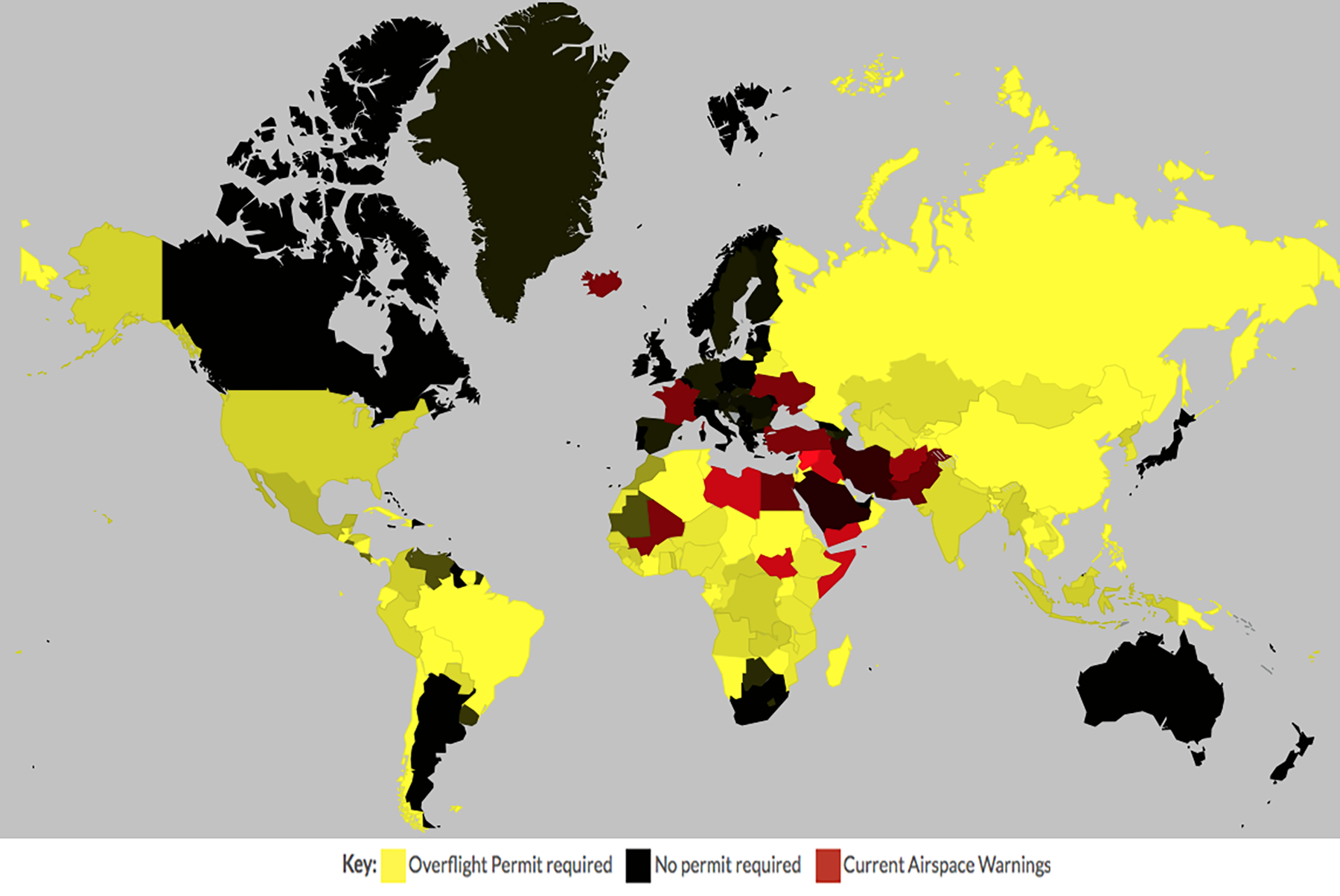
World Overflight Map, from OpsGroup
I recommend you subscribe to OpsGroup if you fly internationally so you aren't at the mercy of the International NOTAM system for figuring out what airspace is hostile and what airspace is not. And as for the runway closures being buried at the bottom of a stack of NOTAMs I have two recommendations:
- Always back up a visual approach with lateral and vertical guidance. (See Wrong Airport for more.)
- Look for a NOTAM decoder that will at the very least prioritize or color code the important NOTAMs so you can bypass all the signage and see what really matters, like a closed runway. ARINCDirect includes such a decoder. But you can find others; just enter "NOTAM Decoder" into your Internet search engine.
5
A game plan for dodging Golden BBs
When the Golden BB finds its mark, lives can be lost, aircraft can be destroyed, and reputations can be tarnished. Then comes the recriminations, investigations, and corrective actions. So if you manage to dodge that Golden BB, none of that happens. Right? Perhaps we should take advantage of having dodged the Golden BB and do the investigation and take the corrective action as if it happened. That could inoculate you from the next Golden BB.
An event in history with a hypothetical twist
Consider the case of Air Florida. The company started in 1972 using two Boeing 707s from Pan American World Airways and ten years later grew to the point where it had a fleet of 58 aircraft and a substantial presence on the east coast of the United States. All of that came to an end with the crash of Air Florida Flight 90. The crew of this Boeing 737 made a number of foolish decisions in what seemed like an effort to avoid a second de-ice application and a misunderstanding of the causes and affects of airframe and engine icing. The airline's lack of experience in dealing with long ground delays during icing conditions as well as the crew's inexperience with winter operations contributed to the loss of the airplane and the deaths of 74 of 79 persons on board.
The Air Florida brand did not survive the crash. All of this is true. But for our hypothetical, let's say the pilots had the presence of mind to firewall the throttles as soon as the stick shaker went off. They could have just barely cleared all obstacles and would have survived had they done so. Would that have been enough for Air Florida to make the changes to their company procedures and crew training to prevent future Golden BBs from finding their targets?
A common event with two possible outcomes
We often hear about line technicians fired from their jobs because they towed an airplane into a hangar door or another aircraft. In many of these cases the line person was at the nose of the aircraft, driving the tug, looking at wing tips from a distance or guessing at tail positions. In the end, the tech loses his or her job and the operator hires a replacement. From here there are two possible outcomes. In some cases, the news of the firing is considered enough to warn everyone to be more careful next time. This usually works, for a while at least. But in other cases the operator realizes the $50,000 winglet could easily have been a $5,000,000 engine or even an injury. Wise operators will realize it will be cheaper in dollars and better for their reputation to hire additional people to ensure they have wing walkers for all aircraft towing operations.
Dodging future Golden BBs
A wise operator realizes that the first dodged Golden BB required a bit of luck and that future dodged Golden BBs will require skill.
- Go public.
- Consider what could have happened.
- Take corrective actions as if the Golden BB had not been dodged.
- Implement your Safety Management System and Consider a Threat Error Management (TEM) Program.
- Understand that you don't know what you don't know.
- Stack the odds in your favor where you can.
- Give the bean counters something big to count.
They say confession is good for the soul. It will certainly help the individuals involved to take the lessons to heart. But it will do more than that. It will help others to realize that this could happen to even the best pilots and it isn't something to be dismissed as a rare event that will only bite the inexperienced. Furthermore, it will get others involved when it comes to finding solutions.
Once you've identified the dodged Golden BB, it will be tempting to think all you need to do is promise yourself to be more careful next time. But what if the circumstances leading to the problem in the first place are systemic, that is, they are part of your normal processes and are bound to happen again. What is to prevent you from falling for these circumstances again, or from others who are unaware of the problem in the first place? The only way to address the problem with the seriousness it deserves is to consider just how bad it could have been. You can easily imagine the obvious: injuries to people, fatalities, damage to the aircraft, or loss of the aircraft. But it can be far worse if the aircraft ends up in a populated area.
Armed with the knowledge that things could have been much worse, you will be prepared to expend time, effort, and money to ensure the Golden BB in question will never reach its target. An aircraft accident will have to be reported to the NTSB, as a start. The company will come under intense public scrutiny. The company may suffer loss of the aircraft and the people on board. If the company survives, things will have to change. So why not make those changes before anything of this magnitude happens in the first place?
You first reaction to a close call may be, "we dodged a bullet!" Your next reaction should be, "Why didn't we catch this sooner?" That is precisely why you need a Threat Error Management (TEM) program. You should come up with ways to trap the errors that led to your close call. But once you've done that you aren't actually done. Every "Plan B" needs to be watched closely for future modifications. The threat is evolving, your Plan B needs to evolve too. More about this: CRM.
Has the airplane ever surprised you? Did it react contrary to what your best systems knowledge and procedural expertise would have predicted? Me too. Some operators shut an engine down after landing thinking it will save wear and tear on the brakes. But carbon-carbon brakes wear very little after landing. (See Carbon-Carbon Brakes for an explanation.) In 1985 the Air Force lost a Sabreliner because the general officer flying it thought it neat to shut an engine down in the flare. But on that particular day the hydraulic pump on the opposite engine was inoperative and he ended up with no brakes and killed himself, his wife, and the instructor pilot. We deviate from standard operating procedures at our own peril.
The best checklists are short and have the most important items up front. Old school checklists were designed for cockpits of three or more, where one crewmember's total focus is on the checklist. Expecting a two pilot crew to run a very long taxi checklist while negotiating with ground control and all the other moving obstacles on the tarmac is asking too much. You can fix that. A G150 operator tells me they moved 17 items from the taxi checklist (when they are moving) to the after start checklist (when the parking brake is set). That's a great way to dodge a Golden BB!
I get the impression that many of the pilots bitten by the need to single engine taxi are enthusiastic supporters of the need to do so. The airline's management figured the amount of time spent with two engines at idle waiting for takeoff as much more costly than just one, and that's a big debit on the balance sheet. Nobody in the accounting department can think of something for the other side of the ledger. I can suggest one for you: the cost of the airplane and the lawsuits sure to follow if you find yourself at 90 knots wondering why you need so much rudder. Other pilots have dodged that Golden BB successfully. But let's add to your woes a contaminated runway and a crosswind. You might not be so lucky.
6
"Your name here"
So do you believe there is a Golden BB out there with your name on it? Regardless of your answer, doesn't it make sense to do everything you can to dodge it and the one coming right after it? Then you need to take the corrective action that would have become necessary had the Golden BB found its target.
References
(Source material)
Aviation Investigation Report A04H0004, Reduced Power at Take-off and Collision With Terrain, MK Airlines Limited, Boeing 747-244SF 9G-MKJ, Halifax International Airport, Nova Scotia, 14 October 2004
Aircraft Accident Report 2/2018, Report on the serious incident to Boeing 737-86J, C-FWGH, Belfast International Airport on 21 July 2017, Air Accidents Investigation Branch, United Kingdom
NTSB Aircraft Accident Report, AAR-69-08, Pan American World Airways, Inc., Boeing 707-321C, N799PA, Elmendorf Air Force Base Anchorage, Alaska, December 26, 1968
